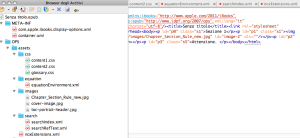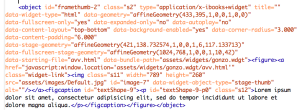Come segnalato ieri da The digital reader, la nuova versione di Ibooks Author aumenta le proprie capacità di authoring aggiungendo il supporto ad EPUB3. Ebbene sì, da oggi è possibile usare Ibooks Author per fare EPUB3. Però non è detto che sia una buona idea.
Prima di entrare nello specifico, due parole su questa azione di Apple. Da un lato è un’ottima notizia: Apple esce dal giardino cintato del proprio formato proprietario .ibooks e permette la creazione di testi in quello aperto di EPUB3. Dall’altro testimonia anche la difficoltà di Apple con il formato .ibooks che non ha avuto la fortuna che forse Apple sperava, anche nel mercato scolastico. Non solo per motivi commerciali, ma anche tecnici: Apple aveva puntato tutto su un formato fortemente fixed, costruito attorno ai suoi iPad, con il paradosso che gli ebook creati su macchine Apple non potevano essere letti da uno dei prodotti più forti della casa di Cupertino, l’iPhone. La scelta di EPUB3 va vista anche in quest’ottica: un escamotage per chi crea testi multimediali su Apple, affinché possa creare una versione reflow leggibile su iPhone o desktop.
Una prova su strada mi ha confermato i pregi e i difetti di questa scelta progettuale di Apple. Il nuovo Ibooks Author infatti, nel momento che si decida di creare un EPUB3, si comporta sostanzialmente come un word-processor/DTP, spegnendo una parte importante delle opzioni offerte a chi crei testi in formato .ibooks: niente forme, grafici, caselle di testo, strumenti per quiz, keynote, immagini interattive, oggetti in 3D, finestre a scomparsa et alia. Rimangono le gallerie di immagini, i filmati/multimedia e i widget, nomignolo per definire piccole pagine HTML5 con CSS indipendenti, codice javascript e file di configurazione proprietari Apple.
Ed è qui che si crea l’importante frattura tra l’EPUB3 di apple e il resto del mondo.
L’EPUB3 esportato da Apple infatti è un EPUB3 che funzionerà bene su macchine Apple, ma funzionerà molto meno bene (o non funzionerà affatto) su altre macchine. Il codice generato da Ibooks Author non è un bel codice, non tiene conto in alcun modo della semantica del testo, nemmeno per le ormai normali gerarchizzazioni del documento. I tag sono usati in modo piatto, appoggiandosi pesantemente sulla grafica definita altrove nei CSS. Non si tratta solo di questione di stile: un documento scarsamente lavorato in senso semantico è poi difficile da usare, nel caso sia necessario fare correzioni o miglioramenti. Girando all’interno dell’EPUB3 si trovano anche file di configurazione XML fuori specifiche EPUB3, e istruzioni CSS Ibooks-only.
Le difficoltà aumentano man mano che aumenta la personalizzazione del codice operata da Ibooks Author, fino ad arrivare a EPUB3 che semplicemente non funzioneranno al di fuori del mondo apple: basta esportare una pagina con un widget per vedere apparire attributi HTML5 personalizzati (i vari data-) e improbabili link javascript a finestre browser che semplicemente non esistono in EPUB3.
Significativo anche il fatto che Ibooks Author permetta anche di importare un ePub, ma solo per fare un .ibooks
Non è possibile importare un ePub creato altrove per continuare il lavoro su Ibooks Author.
Insomma: questa nuova versione di Ibooks Author non solo non è una killer application per il mondo dell’editoria digitale, ma potrebbe fare più danni che benefici per chi lavora in EPUB3. Non è un vero tool di authoring EPUB3, crea file che funzionano (bene) solo su una piattaforma, e non introduce novità sostanziali per chi lavori nell’editoria digitale. Dà l’illusione all’utilizzatore occasionale di lavorare con un formato universale, ma in realtà produce testi ibridi che potranno creare difficoltà se letti con programmi diversi da Ibooks. È anche la mancanza di innovazione che colpisce, specie se questa mancanza proviene da una azienda come Apple. Ibooks Author appare come un programma datato nella sua concezione a stampa della pagina, proponendo al creatore di ebook un’interfaccia estremamente semplice, ma anche molto limitata. Anche il relegare tutto javascript nei piccoli cassetti a inserto dei problematici widget, è una scelta a corto respiro quando si stia creando un EPUB3 di una certa complessità.
Vedremo nei prossimi mesi che risposta ci sarà da parte degli utilizzatori e se i problemi che emergono in questa prima release verranno superati attraverso l’adeguamento del mercato alle specifiche non scritte di Apple (è già successo in passato), o se – al contrario – le politiche di Cupertino si ammorbidiranno.
Make EPUB3 using Ibooks Author
As reported yesterday by The digital reader, the new version of Ibooks Author increases its capabilities by adding support for authoring EPUB3. Yes, now you can use Ibooks Author to create EPUB3. But I do not know if this is a good idea.
Before talking specifically of the new software, two words about this action by Apple. On one side it is excellent news: Apple comes out of the walled garden of its proprietary format .ibooks and allows the creation of texts in EPUB3. On the other hand this testifies the difficulty of the Apple ibooks format. Not only for commercial reasons, but also technicians: Apple had staked everything on a strongly fixed format, built around its iPad, with the paradox that the ebooks created on Apple machines could not be read by one of the strongest of the House of Cupertino, the iPhone. The choice of EPUB3 should be seen also from this perspective: a trick for those who create media texts, using Apple hardware, to have a version readable reflow on iPhone or desktop.
A road test has confirmed to me the pros and cons of this design choice by Apple. The new Ibooks Author indeed, the moment that you decide to create a EPUB3, behaves essentially as a word-processor/DTP, shutting down a major part of options offered to those who create ibooks format texts: no forms, charts, text boxes, quizzes, tools, images, interactive keynote objects in 3D et alia. Remain the image galleries, movies/multimedia and widgets, nickname to define small HTML5 pages with CSS, javascript code and configuration files.
And this is where emerges the important gap between the apple EPUB3 and the rest of the world.
The EPUB3 exported from Apple is a EPUB3 that will work well on Apple machines, but will work much less well (or it won’t work at all) on other machines. The code generated by Ibooks Author is not a good code, does not reflect in any way the semantics of the text, not even for the normal hierarchy of the document. The tags used are flat, leaning heavily on graphics defined elsewhere in the CSS. This is not just a matter of style: a document poorly worked in semantic sense is difficult to use, in case you need to make corrections or improvements. In the Apple’s EPUB3 you can also find non-standard XML configuration file, and CSS instructions Ibooks-only.
The problems increase as it increases the code customization by Ibooks Author, up to EPUB3 that simply won’t work outside of the apple world: just export a page with a widget to see HTML5 custom attributes appear (data-) and improbable javascript links to window/browsers that simply do not exist in EPUB3.
Also significant is the fact that Ibooks Author also allows to import an ePub, but just to make a .ibooks
You cannot import an ePub created elsewhere to continue the work on Ibooks Author.
In short: this new version of Ibooks Author not only is not a killer application for the world of digital publishing, but it could do more harm than good for those working in EPUB3. It is not a true EPUB3 authoring tool, creates files that work (well) on a platform only, and does not introduce substantial innovations for those jobs in digital publishing. Gives the illusion to the occasional user to work with a universal format, but actually produces hybrid texts that can create difficulties if readed with programs other than Ibooks. It is also the lack of innovation that affects, especially if this lack comes from a company like Apple. IBooks Author appears as a program dated in his conception of the printed page, offering to the creator of an extremely simple interface, but also very limited. Also the choice to relegate javascript in drawers/widget, is a short breath when you’re creating a EPUB3 of some complexity.
We will see in the coming months what we will be the response by users and if the problems that emerge in this first release will be overcome through adaptation to Apple’s unwritten rules (as already happened in the past), or – on the contrary – Cupertino policies will be more universal.



